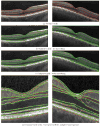An adaptive grid for graph-based segmentation in retinal OCT
- PMID: 27773959
- PMCID: PMC5070700
- DOI: 10.1117/12.2043040
An adaptive grid for graph-based segmentation in retinal OCT
Abstract
Graph-based methods for retinal layer segmentation have proven to be popular due to their efficiency and accuracy. These methods build a graph with nodes at each voxel location and use edges connecting nodes to encode the hard constraints of each layer's thickness and smoothness. In this work, we explore deforming the regular voxel grid to allow adjacent vertices in the graph to more closely follow the natural curvature of the retina. This deformed grid is constructed by fixing node locations based on a regression model of each layer's thickness relative to the overall retina thickness, thus we generate a subject specific grid. Graph vertices are not at voxel locations, which allows for control over the resolution that the graph represents. By incorporating soft constraints between adjacent nodes, segmentation on this grid will favor smoothly varying surfaces consistent with the shape of the retina. Our final segmentation method then follows our previous work. Boundary probabilities are estimated using a random forest classifier followed by an optimal graph search algorithm on the new adaptive grid to produce a final segmentation. Our method is shown to produce a more consistent segmentation with an overall accuracy of 3.38 μm across all boundaries.
Keywords: OCT; adaptive grid; classification; layer segmentation; retina.
Figures






Similar articles
-
Optimal surface segmentation with convex priors in irregularly sampled space.Med Image Anal. 2019 May;54:63-75. doi: 10.1016/j.media.2019.02.004. Epub 2019 Feb 8. Med Image Anal. 2019. PMID: 30836307 Free PMC article.
-
Improving graph-based OCT segmentation for severe pathology in Retinitis Pigmentosa patients.Proc SPIE Int Soc Opt Eng. 2017 Feb 11;10137:101371M. doi: 10.1117/12.2254849. Epub 2017 Mar 13. Proc SPIE Int Soc Opt Eng. 2017. PMID: 28781413 Free PMC article.
-
Longitudinal graph-based segmentation of macular OCT using fundus alignment.Proc SPIE Int Soc Opt Eng. 2015;9413:94130M. doi: 10.1117/12.2077713. Proc SPIE Int Soc Opt Eng. 2015. PMID: 26023248 Free PMC article.
-
Automatic Anisotropic Diffusion Filtering and Graph-search Segmentation of Macular Spectral-domain Optical Coherence Tomographic (SD-OCT) Images.Curr Med Imaging Rev. 2019;15(3):308-318. doi: 10.2174/1573405613666171201155119. Curr Med Imaging Rev. 2019. PMID: 31989882 Review.
-
A Survey of Graph Cuts/Graph Search Based Medical Image Segmentation.IEEE Rev Biomed Eng. 2018;11:112-124. doi: 10.1109/RBME.2018.2798701. Epub 2018 Jan 26. IEEE Rev Biomed Eng. 2018. PMID: 29994356 Review.
Cited by
-
Layer boundary evolution method for macular OCT layer segmentation.Biomed Opt Express. 2019 Feb 4;10(3):1064-1080. doi: 10.1364/BOE.10.001064. eCollection 2019 Mar 1. Biomed Opt Express. 2019. PMID: 30891330 Free PMC article.
-
Multiple-object geometric deformable model for segmentation of macular OCT.Biomed Opt Express. 2014 Mar 4;5(4):1062-74. doi: 10.1364/BOE.5.001062. eCollection 2014 Apr 1. Biomed Opt Express. 2014. PMID: 24761289 Free PMC article.
-
Structured layer surface segmentation for retina OCT using fully convolutional regression networks.Med Image Anal. 2021 Feb;68:101856. doi: 10.1016/j.media.2020.101856. Epub 2020 Oct 14. Med Image Anal. 2021. PMID: 33260113 Free PMC article.
-
INTENSITY INHOMOGENEITY CORRECTION OF MACULAR OCT USING N3 AND RETINAL FLATSPACE.Proc IEEE Int Symp Biomed Imaging. 2016 Apr;2016:197-200. doi: 10.1109/ISBI.2016.7493243. Epub 2016 Jun 16. Proc IEEE Int Symp Biomed Imaging. 2016. PMID: 27695603 Free PMC article.
-
Optimal surface segmentation with convex priors in irregularly sampled space.Med Image Anal. 2019 May;54:63-75. doi: 10.1016/j.media.2019.02.004. Epub 2019 Feb 8. Med Image Anal. 2019. PMID: 30836307 Free PMC article.
References
-
- Guedes V, Schuman JS, Hertzmark E, Wollstein G, Correnti A, Mancini R, Lederer D, Voskanian S, Velazquez L, Pakter HM, Pedut-Kloizman T, Fujimoto JG, Mattox C. Optical coherence tomography measurement of macular and nerve fiber layer thickness in normal and glaucomatous human eyes. Ophthalmology. 2003;110(1):177–189. - PMC - PubMed
-
- Keane PA, Patel PJ, Liakopoulos S, Heussen FM, Sadda SR, Tufail A. Evaluation of age-related macular degeneration with optical coherence tomography. Survey of Ophthalmology. 2012;57(5):389–414. - PubMed
-
- Jindahra P, Hedges TR, Mendoza-Santiesteban CE, Plant GT. Optical coherence tomography of the retina: applications in neurology. Curr Opin Neurol. 2010;23(1):16–23. - PubMed
-
- Hajee ME, March WF, Lazzaro DR, Wolintz AH, Shrier EM, Glazman S, Bodis-Wollner IG. Inner retinal layer thinning in Parkinson disease. Arch Ophthalmol. 2009;127(6):737–741. - PubMed
Grants and funding
LinkOut - more resources
Full Text Sources
Other Literature Sources
